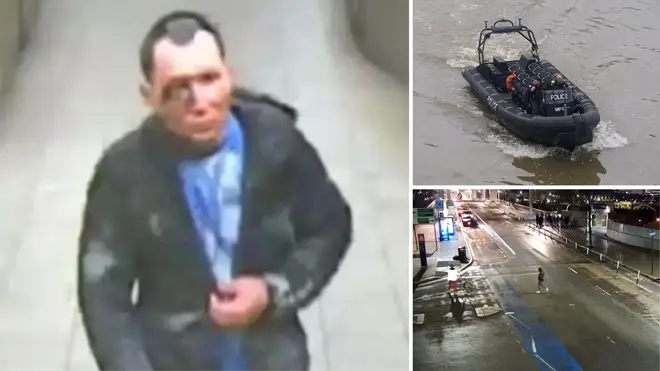
Ben Kentish 10pm - 1am
16 February 2024, 16:52 | Updated: 16 February 2024, 19:15

The Clapham chemical attack suspect may never be found if he went into the Thames, it is feared.
Abdul Ezedi is thought to have gone into the river at Chelsea Bridge, with police using CCTV to build up a detailed picture of his movements after the attack in south London.
He is accused of throwing a corrosive substance at a mother, who is his former partner, and her two young daughters on January 31 before fleeing to the Tube and roaming the capital.
He drops off cameras at the crossing.
Detectives believe Ezedi, who had received a distinctive facial injury that he would need to get help with, would have an "extremely remote" chance of survival if he jumped in.
Diving expert Nicolai Lonne told the Mirror that "murky water" and cold temperatures would make searching the Thames difficult for teams.
And Eric Matechak, who has been boating and fishing on the river for 25 years, said strong tidal movements at Chelsea Bridge would also make it harder to track down a body.

Clapham chemical attack suspect may have jumped in River Thames, police say
"Tidal movements of the Thames can drastically change the water level at any given point," he said.
"Since the Thames is a tidal river, especially around Chelsea Bridge, the water level at 11:30 pm on January 31 would depend on the tidal phase.
"Tides could either cause the river to rise, making it wider and affecting the drift, or fall, potentially exposing parts of the riverbed."
Read more: Specialist police unit begins search of River Thames in hunt for Clapham attack suspect Abdul Ezedi
He added: "River bends and river bed composition would indeed affect where a body might end up.
"The Thames is full of snags, which means that the river's physical features, including bends and the composition of the river bed, could trap or redirect objects.

"Bends could slow down or accelerate the drift, while the riverbed's makeup could catch or allow objects to move freely."
Mr Lonne said: "In Abdul Ezedi's case, the odds are stacked against the search teams for sure. But I know those divers, having trained a bunch myself - they're tenacious and won't quit until they try everything to locate him."
He went on: "With its swirling currents, freezing temps and poor visibility, it presents a new puzzle each time. But with the right skills and gear, there's always hope."
Ezedi, 35, who came from Afghanistan and arrived in the UK from the back of a lorry, was allowed to stay in the UK despite a sexual assault and exposure conviction.
The victim, 31, has not been named. She has been sedated in hospital amid fears she could lose sight in an eye.
Brave witnesses got involved to try and get Ezedi away from her and her children.
He was seen on CCTV on the Tube and in a north London Tesco after the attack, his facial wound clearly visible.
But the main theory is that he jumped in, having been seen pacing on Chelsea Bridge and looking over the railings.
"At that time of night, at this time of year, and entering the water from the middle of a bridge at height, the chances of Ezedi surviving are extremely remote," Met Police Commander Jon Savell said.
"Our Marine Policing Unit will be carrying out boat searches at low tide in the area over the coming days. We have not recovered a body at this stage."